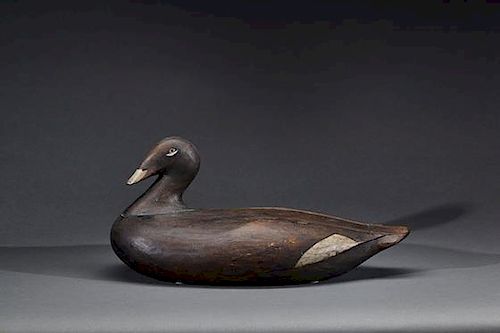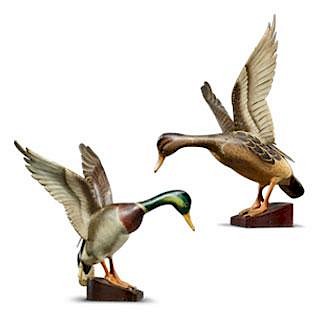White-Winged Scoter Augustus "Gus" Aaron Wilson (1864-1950)
Lot 299
About Seller
Copley Fine Art Auctions
65 Sharp Street
Hingham, MA 02043
United States
Copley Fine Art Auctions is the world's leading American sporting art auction company. Located in Hingham, MA, Copley specializes in antique decoys and 19th- and 20th-century American, sporting, and wildlife paintings. Principal Stephen O'Brien Jr., a fourth-generation sportsman with a refined colle...Read more
Estimate:
$5,000 - $8,000
Absentee vs Live bid
Two ways to bid:
- Leave a max absentee bid and the platform will bid on your behalf up to your maximum bid during the live auction.
- Bid live during the auction and your bids will be submitted real-time to the auctioneer.
Bid Increments
| Price | Bid Increment |
|---|---|
| $0 | $50 |
| $1,000 | $100 |
| $2,500 | $250 |
| $5,000 | $500 |
| $10,000 | $1,000 |
| $25,000 | $2,500 |
| $50,000 | $5,000 |
About Auction
By Copley Fine Art Auctions
Feb 17, 2017 - Feb 18, 2017
Set Reminder
2017-02-17 11:00:00
2017-02-18 11:00:00
America/New_York
Bidsquare
Bidsquare : The Winter Sale
https://www.bidsquare.com/auctions/copley/the-winter-sale-2109
Copley Fine Art Auctions cinnie@copleyart.com
Copley Fine Art Auctions cinnie@copleyart.com
- Lot Description
White-Winged Scoter
Augustus "Gus" Aaron Wilson (1864-1950)
South Portland, ME c. 1900
"Wilson looked at waterfowl much the way the Ward brothers did. There was a similarity in their ability to capture an unusual pose and to produce a decoy that continues to enthrall even the seasoned gunners who have spent their lives observing waterfowl." -Maine decoy author and historian, Captain John Dinan
This bold carving features an inletted and turned head with painted eyes, refined bill detail, and raised wings. These Monhegan Island birds were made famous in Quintina Colio's book "American Decoys" which featured four rigmates. This grand bird is over seventeen and one-half inches long, and over eight inches wide. The two-piece construction features a prodigious inletted head seat.
Wilson was born on Mount Desert Island, Maine. Though he is foremost remembered as a carver, he was also a boat builder, waterman, outdoorsman, and lighthouse keeper. He was an attendant to a number of Maine's lighthouses, including the Great Duck Island Light, Goose Rocks Station on Fox Island, Two Lights Station on Cape Elizabeth, Marshall Point Light at Port Clyde, and Spring Point Ledge Lighthouse in Casco Bay.
According to art historian Gene Kangas, "His job as a lighthouse keeper provided financial security and ample time to facilitate rapid artistic advancement. Imaginative decoys and wildlife carving began to take shape in an incredible variety of poses." Early regional traditions and requirements drove carvers to produce big solid decoys with modest paint patterns. "Seaworthiness, durability, practicality, effectiveness and affordability were essential considerations...Wilson's genius is demonstrated by his ability to work within those existing traditions, yet elevate the Maine decoy to a higher level of artistic achievement."
Wilson's interests were by no means limited to decoys. He carved a variety of songbirds, decoratives, weathervanes, and big cats. A pair of Wilson's tigers are featured in the American Identities exhibit, on display as a part of the permanent collection of the Brooklyn Museum, Brooklyn, New York.
Original paint with even wear mostly down to wood, faint age line in the head reglued, and gunning wear.
PROVENANCE: Private Collection, Nantucket, purchased from Samuel Lowe Antiques, Charles Street, Boston, Massachusetts, in 1977, selected from a rig of six Wilson decoys LITERATURE: Gene Kangas, "Gus Wilson, Folk Artist," Decoy Magazine, Lewes, DE, November/December 1994, pp. 8-13. Quintina Colio, American Decoys, Ephrata, PA, 1972, pp. 30-31.
Joe Engers, ed. The Great Book of Wildfowl Decoys, San Diego, CA, 1990, pp. 36-41.Condition report requests can be made via email or by telephone (info@copleyart.com or 617.536.0030). Any condition statement given is a courtesy to customers, Copley will not be held responsible for any errors or omissions. The absence of a condition statement does not imply that the lot is in perfect condition.Condition
- Shipping Info
-
Shipping info
Copley Fine Art Auctions does not handle the shipping of any items. Shipping is the sole responsibility of the buyer. Once your payment has cleared, and we have received your authorized shipping release form items may be released for shipment. Copley Fine Art Auctions, LLC shall have no liability for any loss or damage to such items. Buyers should allow up to four weeks for shipment.PLEASE BE AWARE THAT INTERNET BIDDERS MAY NOT PICK UP THEIR ITEMS AT THE SALE SITE. ITEMS CAN BE PICKED UP BY APPOINTMENT OR SHIPPED STARTING FIVE DAYS AFTER THE CONCLUSION OF THE SALE
-
- Buyer's Premium



 EUR
EUR CAD
CAD AUD
AUD GBP
GBP MXN
MXN HKD
HKD CNY
CNY MYR
MYR SEK
SEK SGD
SGD CHF
CHF THB
THB






